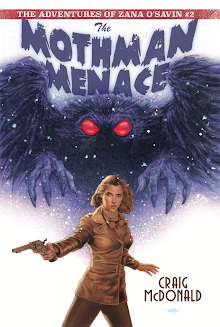The Hector Lassiter novels (ten of them, including HEAD GAMES) frequently incorporate real
people.
All of that carries over into HEAD GAMES, THE GRAPHIC NOVEL, coming Oct. 24, 2017 from First Second Books.
The range of “real characters” is prodigious, from the real-life
personalities who dominate some of those books’ action, to those real people
who are, well, fleeting, yet still influential.
Some are famous, some are even infamous.
Some are little known to the wider public, yet they affected the course
of history and the Lassiter series sometimes aims to give these historical ghosts
their proper due.
To give a little bonus context to those “characters” who appear in HEAD
GAMES: THE GRAPHIC NOVEL, we’re delving into each, here and there, over successive
Thursdays…
Consistent with a term coined by director Alfred Hitchcock
for a pivotal plot device to drive narrative, Francisco “Pancho” Villa—or
rather, his skull—is the so-called “MacGuffin” that fires the plot of HEAD
GAMES.
Villa was a bandit turned eventual General in the Mexican
Revolution during the first few years of the 20th Century under the
direction of eventually slain Mexican President Francisco Madero.
Madero’s death led to a power vacuum that sent various
military leaders like Villa scrambling to win U.S. favor and, by extension, the
throne of Mexico.
For a time, Villa was a favorite for American support, until
President Woodrow Wilson threw U.S. backing behind another. Enraged, Villa
mounted an attack against the U.S. town of Columbus, New Mexico, slaying about
a dozen civilians and soldiers, and injuring many others, including one named, ahem, Lassiter (for real).
That terrorist attack on U.S. soil triggered the “Punitive
Expedition” which resulted in General John “Black Jack” Pershing and a young and
blood-hungry George S. Patton leading an army of callow young U.S. soldiers (an
under-age and vengeful Hector Lassiter among them) across the border and into the Mexican
desert in pursuit of Villa.
But the Great Chase was a Big Bust.
The soldiers, Hector again among them, were called back across
the Rio Grande after about a year and shipped over to Europe and the trenches
of World War I.
Villa eventually retired, settled down, but was brutally
assassinated on the streets of Parral, Mexico, on July 20, 1923: Memories were
evidently long, and blood feuds demand bloodshed, in and around the
Borderlands.
Three years later, Pancho’s grave was robbed and his head
chopped off and stolen.
It is officially missing to this day. Rumors of its
whereabouts abound:
Some place it in the “Tomb” of Yale University’s Skull and
Bones Society (see HEAD GAMES, THE GRAPHIC NOVEL); others claim it became a macabre
pen-holder on the desk of one-time power rival Álvaro Obregón.
There are also tales the skull contains or somehow comprises
a map to the lost treasure of Pancho Villa… More fuel for the HEAD GAMES’
fictional fires.
Next time: Ernest Hemingway












































No comments:
Post a Comment